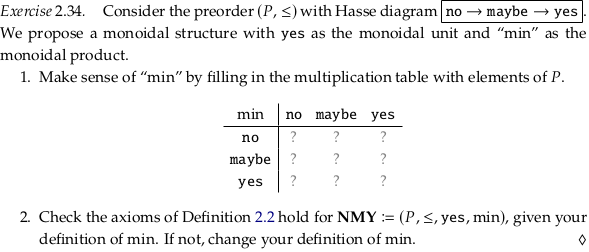Exercise 2.34#

For 1., in the following table we use 0 for no, 0.5 for maybe, and 1 for yes:
import pandas as pd
preorder = [0, 0.5, 1]
min = pd.DataFrame(index=preorder, columns=preorder, data=[[0,0,0], [0,0.5,0.5], [0,0.5,1]])
display(min)
| 0.0 | 0.5 | 1.0 | |
|---|---|---|---|
| 0.0 | 0 | 0.0 | 0.0 |
| 0.5 | 0 | 0.5 | 0.5 |
| 1.0 | 0 | 0.5 | 1.0 |
For 2 notice the min function is associative; see Associative property - Examples. The yes element can be used as a monoidal unit. It’s easy to see the symmetry/commutativity property is satisfied in the truth table.
To see the monotonicity condition is satisfied we’ll use as an inference rule that a
partially-applied min function is order-preserving (i.e. monotone). That is, if we have that \(a_1 \leq a_2\), it
follows that \(min(a_1, b) \leq min(a_2, b)\). Then, starting from these two premises:
$\(
\begin{align} \\
x_1 & \leq y_1 \\
x_2 & \leq y_2 \\
\end{align}
\)$
Applying \(min(\_, y_2)\) to the first premise:
Applying \(min(x_1, \_)\) to the second premise:
And combining \(\eqref{eq:34a}\) and \(\eqref{eq:34b}\) with transitivity: